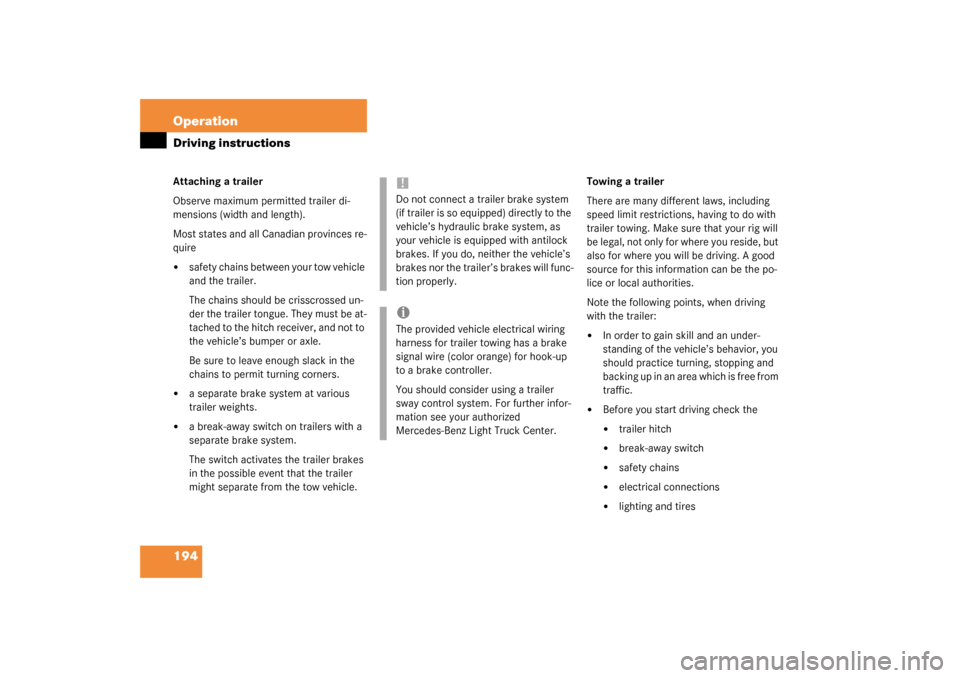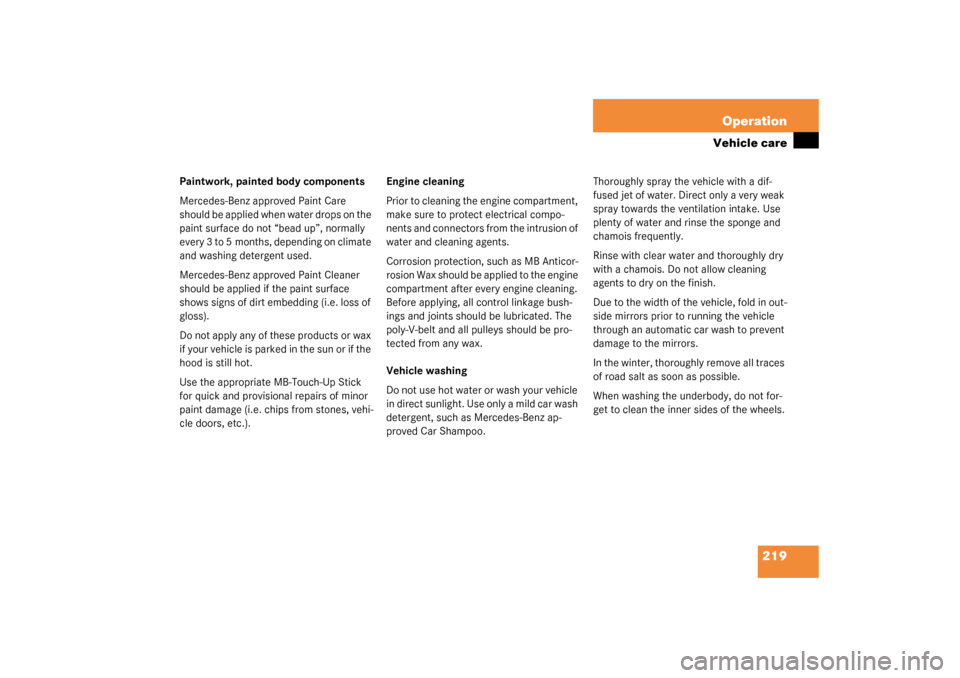Page 194 of 321

194 OperationDriving instructionsAttaching a trailer
Observe maximum permitted trailer di-
mensions (width and length).
Most states and all Canadian provinces re-
quire�
safety chains between your tow vehicle
and the trailer.
The chains should be crisscrossed un-
der the trailer tongue. They must be at-
tached to the hitch receiver, and not to
the vehicle’s bumper or axle.
Be sure to leave enough slack in the
chains to permit turning corners.
�
a separate brake system at various
trailer weights.
�
a break-away switch on trailers with a
separate brake system.
The switch activates the trailer brakes
in the possible event that the trailer
might separate from the tow vehicle.Towing a trailer
There are many different laws, including
speed limit restrictions, having to do with
trailer towing. Make sure that your rig will
be legal, not only for where you reside, but
also for where you will be driving. A good
source for this information can be the po-
lice or local authorities.
Note the following points, when driving
with the trailer:
�
In order to gain skill and an under-
standing of the vehicle’s behavior, you
should practice turning, stopping and
backing up in an area which is free from
traffic.
�
Before you start driving check the�
trailer hitch
�
break-away switch
�
safety chains
�
electrical connections
�
lighting and tires
!Do not connect a trailer brake system
(if trailer is so equipped) directly to the
vehicle’s hydraulic brake system, as
your vehicle is equipped with antilock
brakes. If you do, neither the vehicle’s
brakes nor the trailer’s brakes will func-
tion properly.iThe provided vehicle electrical wiring
harness for trailer towing has a brake
signal wire (color orange) for hook-up
to a brake controller.
You should consider using a trailer
sway control system. For further infor-
mation see your authorized
Mercedes-Benz Light Truck Center.
Page 214 of 321

214 OperationWinter drivingBlock heater (Canada only)
The engine is equipped with a block heat-
er.
The electrical cable may be installed at
your authorized Mercedes-Benz Center.
Snow chains
Snow chains should only be driven on
snow-covered roads at speeds not to ex-
ceed 30 mph (50 km/h). Remove chains
as soon as possible when driving on roads
without snow. Observe the following guidelines when us-
ing snow chains:
�
Chains should only be used on all four
wheels. With only two chains available,
they should be mounted on the rear
wheels. Follow the manufacturer’s
mounting instructions.
�
Use only snow chains that are ap-
proved by Mercedes-Benz. Your autho-
rized Mercedes-Benz Light Truck
C e n t e r w i l l b e g l a d t o a d v i s e y o u o n t h i s
subject.
iWhen driving with snow chains, you
may wish to deactivate the ESP
(�page 76) before setting the vehicle
in motion. This will improve the
vehicle’s traction.
!ML 55 AMG
Do not use snow chains with tire size
285/50 R 18.
Page 218 of 321

218 OperationVehicle careYour vehicle has been treated at the facto-
ry with a wax-base rustproofing in the body
cavities which will last for the lifetime of
the vehicle. Post-production treatment is
neither necessary nor recommended by
Mercedes-Benz because of the possibility
of incompatibility between materials used
in the production process and others ap-
plied later.
We have selected car-care products and
compiled recommendations which are
specially matched to our vehicles and
which always reflect the latest technology.
You can obtain Mercedes-Benz approved
car-care products at your authorized
Mercedes-Benz Light Truck Center.Scratches, corrosive deposits, corrosion or
damage due to negligent or incorrect care
cannot always be removed or repaired with
the car-care products recommended here.
In such cases it is best to seek aid at your
authorized Mercedes-Benz Light Truck
Center.
The following topics deal with the cleaning
and care of your vehicle and give important
“how-to” information as well as references
to Mercedes-Benz approved car-care prod-
ucts.
Additional information can be found in the
booklet entitled “Vehicle Care Guide”.Power washer
When using a power washer for cleaning
the vehicle, always observe manufactur-
er’s operating instructions.
Tar stains
Quickly remove tar stains before they dry
and become more difficult to remove. A tar
remover is recommended.
!Never use a round nozzle to power
wash tires. The intense jet of water can
result in damage to the tire.
Always replace a damaged tire.
Always keep the jet of water moving
across the surface. Do not aim directly
at electrical parts, electrical connec-
tors, seals, or other rubber parts.
Page 219 of 321

219 Operation
Vehicle care
Paintwork, painted body components
Mercedes-Benz approved Paint Care
should be applied when water drops on the
paint surface do not “bead up”, normally
every 3 to 5 months, depending on climate
and washing detergent used.
Mercedes-Benz approved Paint Cleaner
should be applied if the paint surface
shows signs of dirt embedding (i.e. loss of
gloss).
Do not apply any of these products or wax
if your vehicle is parked in the sun or if the
hood is still hot.
Use the appropriate MB-Touch-Up Stick
for quick and provisional repairs of minor
paint damage (i.e. chips from stones, vehi-
cle doors, etc.).Engine cleaning
Prior to cleaning the engine compartment,
make sure to protect electrical compo-
nents and connectors from the intrusion of
water and cleaning agents.
Corrosion protection, such as MB Anticor-
rosion Wax should be applied to the engine
compartment after every engine cleaning.
Before applying, all control linkage bush-
ings and joints should be lubricated. The
poly-V-belt and all pulleys should be pro-
tected from any wax.
Vehicle washing
Do not use hot water or wash your vehicle
in direct sunlight. Use only a mild car wash
detergent, such as Mercedes-Benz ap-
proved Car Shampoo.Thoroughly spray the vehicle with a dif-
fused jet of water. Direct only a very weak
spray towards the ventilation intake. Use
plenty of water and rinse the sponge and
chamois frequently.
Rinse with clear water and thoroughly dry
with a chamois. Do not allow cleaning
agents to dry on the finish.
Due to the width of the vehicle, fold in out-
side mirrors prior to running the vehicle
through an automatic car wash to prevent
damage to the mirrors.
In the winter, thoroughly remove all traces
of road salt as soon as possible.
When washing the underbody, do not for-
get to clean the inner sides of the wheels.
Page 230 of 321

230 Practical hintsWhat to do if …Problem
Possible cause
Suggested solution
/
The yellow coolant warning lamp
lights up when the engine is run-
ning.
The coolant is to hot.
The coolant level is too low.
�
Stop as soon as possible and allow
the engine and coolant to cool down.
�
Check the coolant level and add
coolant if necessary (
�page 206).
If the warning lamp lights up frequently, there
is a leak in the cooling system.
�
Have the cooling system checked by
an authorized Mercedes-Benz Light
Truck Center.
The coolant temperature gauge is above
248 °F (120 °C).
The coolant level is too low.
�
Stop as soon as possible and allow
the engine and coolant to cool down.
�
Add coolant to prevent engine from
overheating (
�page 206).
If the coolant level is correct, the electrical
radiator fan may be broken.
�
If the coolant temperature is below
the red zone, drive on to the nearest
authorized Mercedes-Benz Light
Truck Center.
Avoid high engine loads (e.g. driving
uphill) and stop-and-go driving.
Page 246 of 321
246 Practical hintsOpening/closing in an emergency
Opening/closing in an emergencySliding/pop-up roof*
The sliding/pop-up roof drive is located
behind the cover between the front interior
lamps.
You can open or close the sliding/pop-up
roof manually should an electrical malfunc-
tion occur.
1Hexagon drive hole
2Crank
3Cover
�
Pry off cover3 using a flat blade srew-
driver.
�
Obtain crank2 (supplied with vehicle)
and insert in hexagon drive1
�
Turn crank2 clockwise to:�
slide roof closed
�
raise roof at the rear
�
Turn crank2 counterclockwise to:�
slide roof open
�
lower roof at the rear
The sliding/pop-up roof must be synchro-
nized if it has been operated manually
(
�page 138).iPush crank2 upward while turning it,
to disengage the electric motor.
Page 249 of 321
249 Practical hints
Replacing bulbs
Replacing bulbs for front lamps
Replacing low beam bulbs
1Low beam halogen or Bi-Xenon* head-
lamp cover with locking tab2Electrical connector
Bi-Xenon* headlampHalogen headlamp
�
Switch off the lights.
�
Open the hood (
�page 202).
�
Push down tab at top end of cover1
and remove.
�
Pull electrical connector2 off.
�
Unclip the retainer springs and take out
the bulb.
�
Insert the new bulb so that the base lo-
cates in the recess on the holder.
�
Clip the retainer springs.
�
Plug the connector2 onto the bulb.
�
Align headlamp cover and click into
place.
Warning!
G
Do not remove the cover1 for the Bi-Xenon
headlamp. Because of high voltage in xenon
lamps, it is dangerous to replace the bulb or
repair the lamp and its components. We rec-
o mme n d th at y o u h av e s uc h wo rk don e by a
qualified technician.
Page 250 of 321
250 Practical hintsReplacing bulbsHigh beam bulbs
1High beam headlamp cover with lock-
ing tab�
Switch off the lights.
�
Open the hood (
�page 202).
�
Twist cover1 counterclockwise and re-
move.2Electrical connector
�
Pull electrical connector2 off.
�
Unclip the retainer springs and take out
the bulb.
�
Insert the new bulb so that the base lo-
cates in the recess on the holder.
�
Clip the retainer springs.
�
Plug the connector2 onto the bulb.
�
Align headlamp cover and click into
place.Turn signal, parking, standing and side
marker lamp bulbs
1Bulb socket
�
Switch off the lights.
�
Open the hood (
�page 202).
�
Twist bulb socket1 counterclockwise
and pull out.
�
Push bulb into socket, turn counter-
clockwise and remove.
�
Insert new bulb in socket, push in and
twist clockwise.
�
Reinstall the bulb socket.
��